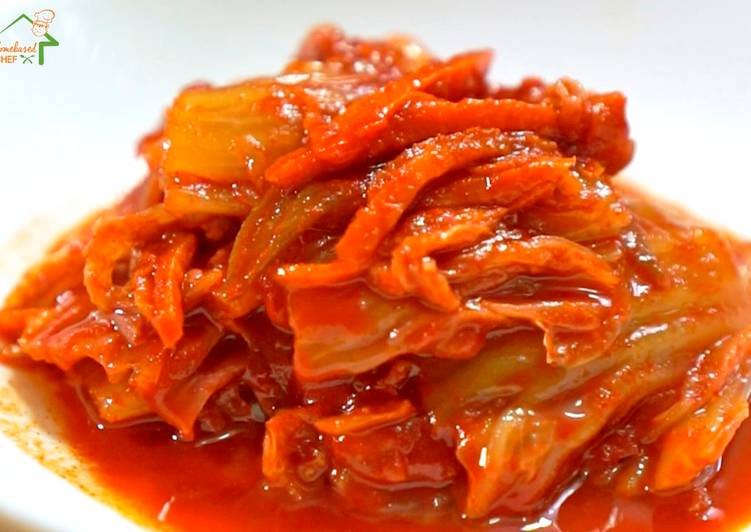Korean Kimchi. The primary role of Korean Food Dishes was not. Apart from daily food, one should always try for different regional cuisine. Repeat layering all of the cabbage has been salted.
 Originated from pickled vegetables, there are now hundreds of kimchi varieties in Korea.
If you love authentic Korean cuisine, you'll want to try your hand at creating your own kimchi; it's not as complicated or time-consuming as you might think.
Kimchi is a fermented dish, the more it ages the better it tastes, likewise with the sugar.
You can have Korean Kimchi using 14 ingredients and 7 steps. Here is how you cook it.
Originated from pickled vegetables, there are now hundreds of kimchi varieties in Korea.
If you love authentic Korean cuisine, you'll want to try your hand at creating your own kimchi; it's not as complicated or time-consuming as you might think.
Kimchi is a fermented dish, the more it ages the better it tastes, likewise with the sugar.
You can have Korean Kimchi using 14 ingredients and 7 steps. Here is how you cook it.
Ingredients of Korean Kimchi
- It's 2 pieces of Chinese Cabbage.
- It's 1/2 cup of Rock Salt.
- Prepare 1/2 cup of Glutinous Rice Flour.
- You need 1/4 cup of White Sugar.
- Prepare 3 cups of Water.
- You need 1 cup of Garlic.
- You need 2 tablespoons of Ginger.
- You need 1 cup of White Onion.
- It's 1 cup of Fish Sauce.
- Prepare 2 cups of Gochugaru.
- Prepare 4 stalks of Leeks.
- It's 1 piece of Carrot.
- It's 1 piece of Radish.
- Prepare of Honey (optional).
Use a persimmon in place of the apple, if you prefer. Koreans eat it at nearly every meal. It can be fresh, like a salad, or it can be fermented. While the most popular variety is spicy kimchi made of cabbage, there are hundreds of different types of kimchi made of different vegetables, and not all of them spicy.
Korean Kimchi instructions
- PREPARE THE CABBAGE Cut the cabbage lengthwise into quarters, then chop into bite-size pieces. Soak in cold water for 5 minutes. Drain and transfer to a large bowl..
- Add 1/2 cup salt and mix well; turn it over after 30 minutes. - repeat 2x (total of 1 hour) Rinse and drain for 3x. Squeeze out water on the last time, put on a strainer and let it air dry for 30 minutes..
- MAKE THE GLUTINOUS PASTE Dilute the rice flour in water. Heat and bring to boil while stirring, for about 5 minutes. Lower the heat. When you see it bubbling, add sugar. Cook for a few more minutes until it becomes translucent. Let it cool completely. Tip: To cool faster, but the pot in a pan half-filled with water; just make sure that the pot is taller than the pan..
- PREPARE THE KIMCHI SAUCE Using the food processor, chop and blend the garlic, ginger, onion, and fish sauce for about 1 minute. Mix it with the cooled glutinous paste and hot pepper flakes..
- Wash the leeks thoroughly. Dry it with paper towel and cut diagonally. Peel the carrot and radish and cut into thin strips. Add the leeks, carrots, radish, (and honey) to the kimchi sauce and mix well. You can taste test and adjust depending on the level of heat, saltiness, and sweetness that you prefer..
- MIX THE KIMCHI In a clean large bowl, put the cabbage and add the sauce gradually. Use clean and dry hands (or use a clean food-grade gloves) to mix the ingredients. Make sure to distribute the kimchi sauce evenly and all cabbage pieces have been covered with sauce. Transfer to a clean container and press it to remove air bubbles. Leave at room temperature and place in a dark area or cover it with dry clean towel. Transfer to the ref on the 3rd day..
- Best eaten after its 1st to 2nd week of fermentation..
Kimchi is also a main ingredient in many other Korean dishes. Kimchi is usually served as a side dish to complement various dishes but it has been used as a garnish for burgers and even hotdogs. And when kimchi becomes over ripe, you can use it to make Korean Style Pancakes, and Kimchi Fried Rice. Try kimchi with the following dishes. Traditional Korean kimchi is wonderful, but it requires more complex steps and ingredients that are harder to source.